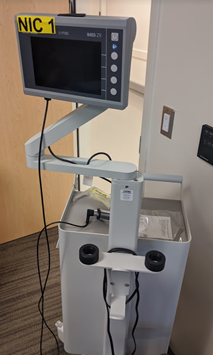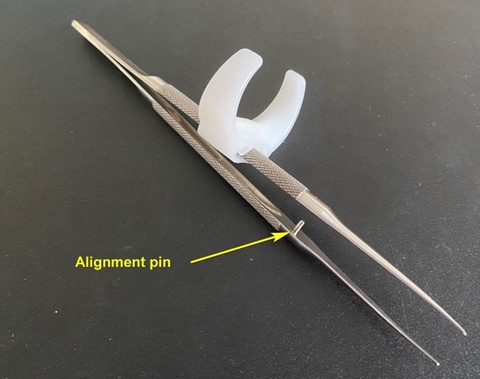Surgical Wings: A Forceps-based Device Designed to Improve Surgeon Hand Ergonomics
Surgical instruments have been constantly evolving throughout the history of surgery. While minimally invasive and robot-assisted operations have gained popularity in the last decade, open operations and handheld instruments remain the foundation of surgical practice worldwide. Multiple studies have demonstrated that hand fatigue and discomfort are not uncommon during both open and minimally invasive operations. Surgeons may experience hand fatigue and hand discomfort due to the mechanical strain of manipulating an instrument. Suboptimal ergonomic may lead not only to hand discomfort and fatigue but may also affect the steadiness of manipulation. Forceps are the most commonly used tools in surgery. Forceps with wider or rounded handles and double action mechanisms have been developed and manufactured to improve ergonomics. Yet many challenges remain.
Arshava Surgical Wings (ASWs) are forceps-based support attachments for use during operations. As a support device, ASWs were designed to increase stability of manipulations, improve ease of forceps use, and decrease hand fatigue and discomfort such as cramps and pain. ASWs are intended to be beneficial during long operations, with the use of long forceps, and for sustained retraction of dense tissues. This is the first device that was developed to improve ergonomics of forceps use.
Functional evaluation has shown this device to increase steadiness of manipulations and augment hand relaxation during use of forceps in a study involving 21 surgeons and surgical trainees (Arshava et al. 2022). The steadiness on sustained forceps pinch was improved by 24% with the use of ASWs, regardless of the level of training or gender of the surgeon. The use of ASW allowed, on average, a 27 % decrease in muscle effort during intermittent pinch manipulations, as demonstrated by surface electromyography. The decrease in muscle effect was more noticeable in females (34% versus 21% in males) and faculty surgeons (31% versus 23% in trainees). The use of the device did not negatively affect the accuracy or speed of the peg board task. Subjective feedback from the participants on use of the device was favorable and consistent with objective measurement.
Device description
The device consists of “Thumb” and “Fingers” units that are adjustably positioned on the forceps shafts based on surgeons’ preference (Fig. 1).

The Wings have attachment slots through which they are slid onto the forceps. The “Thumb” unit is naturally positioned closer to the forceps hinge, while the “Fingers” unit is placed closer towards the tips. We suggest that the units be positioned to not overlap. The final location of the units on the forceps largely depends on the individual preferences of the surgeon.
The exact position of fingers on the Wings is determined by the user per individual preference and may depend on the length of the forceps used. Generally, we suggest placing the distal phalanx of the fingers on the landing zones of the Thumb and Fingers units and not advancing them past the distal interphalangeal joints.
On the Fingers unit, surgeons can choose the position of the index finger either on the upper wing (Figure 2A) or on top of the attachment slot (Figure 2B) based on their preferred way of holding forceps in an everyday practice.


Figure 2A Figure 2B
Wings are symmetrical in shape and can be interchangeably used in the right and left hands without the need to reposition the units.
While optimally both units are used on the forceps simultaneously, surgeon may choose to use either the Fingers or Thumb unit alone based on preference.
Sizes
Wings are manufactured in regular (gray color) and small (white color) sizes.
We suggest surgeons with glove size <6.5 use the small size, and surgeons with gloves size >6.5 use the regular size. Final size selection is up to the individual user.
Compatible forceps types
ASWs are designed to be compatible with most commonly used surgical forceps with flat and rounded handles. The attachment slot has expansion flaps that allow the Wings to accommodate wider handles (Figure 3). Some wider handles will require certain force for advancement through the slots. Wings are made of a high-quality polypropylene and will tolerate moderate expansion.

The Wings are intended to be used on a single pair of forceps for an entire operation. It is possible to replace Wings onto another set of forceps if necessary. Attachment slots that have been already used will accommodate replacement forceps with the same handle thickness that was used previously. To replace Wings with a stretched expansion flaps onto forceps with a smaller handle than used before, the expanding flaps can be forced back with the tip of the forceps or the back of closed scissors to their original position towards the center (Figure 4).

Current limitations
ASWs will not fully fit on forceps with a very wide handle (e.g, Ferris-Smith forceps). In this case the Fingers unit can be pushed as far as the attachment slots allow on one handle and used as just a single attachment (Fig 5A).

Wings cannot be fully positioned on forceps that have an alignment pin. For such forceps types either the Fingers or Thumb units can be used per the surgeon’s preference on the handle without a pin (Figure 5B and 5C).


Figure 5B Figure 5C
Device availability
The intellectual property of the device is protected by patent application. ASWs are currently manufactured by Iowa MADE (www.iowamade.org). For product ordering or inquiries, please email iowa-made@uiowa.edu, or visit www.iowamade.org.
References
Arshava EV et al. “Surgical Wings": Forceps-based Device Improves Surgeon Hand Ergonomics. Presented at the American College of Surgeons Clinical Congress, San Diego, CA, October 2022.